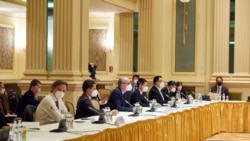During a May 31 meeting, the International Atomic Energy Agency (IAEA) reported to its members about Iran’s lack of cooperation in responding to questions about its nuclear activities, including an increased level of uranium enrichment.
A copy of the IAEA report obtained by Reuters revealed that Iran has failed to explain uranium traces at undeclared sites.
“The lack of progress in clarifying the Agency's questions concerning the correctness and completeness of Iran's safeguards declarations seriously affects the ability of the Agency to provide assurance of the peaceful nature of Iran's nuclear programme,” the report said.
According to CBS News, which also obtained a copy of the IAEA report, the agency said it hasn’t accessed key information on Iran’s program since February 23 and was concerned about its inability to verify what activities have been conducted at some sites.
The head of Iran’s Atomic Energy Organization, Ali Akbar Salehi, said in a June 1 letter to the IAEA that his country has “[d]one its outmost efforts to cooperate with the agency substantively and provide the necessary clarifications and responses.”
Parts of Salehi’s letter were tweeted by Iran’s envoy to the United Nations’ nuclear watchdog in Vienna, Kazem Gharibabadi. The letter conveyed Iran’s willingness to engage “in a proactive and focused effort to resolve the issues without any delay.”
As U.N. reports show, the claim that Iran has done its “utmost” to cooperate is false.
In a May 26 interview with the Financial Times, IAEA chief Rafael Grossi warned that the level of uranium enrichment in Iran’s nuclear program approaches weapons-grade purity.
“A country enriching at 60 per cent is a very serious thing — only countries making bombs are reaching this level. Sixty per cent is almost weapons grade, commercial enrichment is 2, 3 [per cent],” Grossi told the Times. (Enrichment is the process of enhancing natural uranium ore so that it can sustain a nuclear reaction to fuel power plants or make atomic bombs.)
Iran insists that its nuclear program is for medical purposes and research, not weapons.
The IAEA’s findings came as signatories of the 2015 accord to regulate Iran’s nuclear program participate in a fifth round of talks to revive the pact after the U.S. unilaterally pulled out three years later under then-President Donald Trump.
The United States, Germany, France, Britain, China and Russia agreed to the original deal, known as the Joint Comprehensive Plan of Action (JCPOA). After withdrawing, the Trump administration imposed sweeping sanctions on Iran, which scaled back cooperation in 2019.
Iran has tied its willingness to negotiate to the removal of U.S. sanctions.
The IAEA has repeatedly voiced its concerns about undeclared Iranian nuclear activities. In its February report, the IAEA stressed that Iran had not answered its questions.
In December 2020, The Associated Press said it had obtained satellite images showing the beginning of construction on a site at Iran’s Fardo underground nuclear facility. Iran did not provide any public acknowledgement or explain the purpose of the construction.
On February 23, Iran suspended working under a protocol that allows inspectors access to information about its nuclear program so they can look for malign intent. However, on May 24, Iran decided to extend its cooperation for an additional month.
The Arms Control Association, a nonpartisan organization that promotes arms control, said that Iran’s decision to halt and resume cooperation is an attempt to narrow the window for the U.S. to revive the nuclear deal.
Laurence Norman, who writes for The Wall Street Journal from Brussels, tweeted on May 31 that Iran appears to be buying time in the run-up to its presidential elections this month.
Elliott Abrams, for a time the Trump administration’s special representative on Iran, cited media reports about Iran’s clandestine efforts to hide its program in a blog post for the Council on Foreign Relations.
According to Abrams, Iran has been actively trying to conceal its nuclear program and has even sought elements to extend its nuclear arsenal, in contrast to countries like Libya and South Africa, which sought international assistance to get rid of their nuclear weapons programs.
The National, a private English-language newspaper based in the United Arab Emirates, reported on May 4 that Dutch intelligence revealed findings on Iran’s quest in Europe for technology to develop weapons of mass destruction. The newspaper said similar reports came from Germany and Sweden.
Turkish public broadcaster TRT tweeted on May 23 that Iran has blocked the IAEA from viewing satellite imagery of all its nuclear sites.
Western diplomats say reaching a nuclear agreement with Iran remains crucial, so that international inspectors can access Iran’s facilities. Hardliners are expected to usher in a new Iranian president in the elections later this month, The Associated Press reported.
Al-Monitor, an independent Middle East news site based in Washington, D.C., reported on June 2 that Iran President Hassan Rouhani told cabinet members that problems with the U.S. nuclear negotiations in Vienna have mostly been resolved, hinting at a possible deal.






